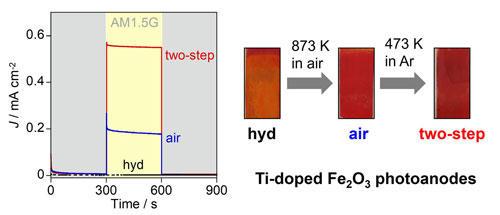
Effect of two-step annealing on photoelectrochemical properties of hydrothermally prepared Ti-doped Fe_{2}O_{3} films
D.O.B. Apriandanu, S. Nomura, S. Nakayama, C. Tateishi, F. Amano
Catalysis Today 2022, in press, https://doi.org/10.1016/j.cattod.2022.06.041
Hematite (α-Fe_{2}O_{3}, bandgap ~2.1 eV) is a potential photoanode candidate for photoelectrochemical water splitting. In this work, we report the preparation of Fe_{2}O_{3} with Ti~{4+} doping by hydrothermal treatment at 393 K and then annealing in the air at 873 K, with a second round of annealing in argon at 473 K. The two-step annealing process increased the photoelectrochemical performance of Ti-doped Fe_{2}O_{3} on a fluorine-doped tin oxide (FTO)-coated glass substrate (FTO/Ti-Fe_{2}O_{3}) for water oxidation in 0.1 mol L~{−1} NaOH solution. Ti~{4+} doping was sourced from TiCl_{4} in ethanol solutions of various concentrations. An energy-dispersive X-ray spectrometer (EDS) analysis confirmed that the optimized Ti/Fe atomic ratio in the solution was ~3%, which showed the highest photocurrent densities in the linear sweep voltammetry and chronoamperometry measurements. The two-step annealed FTO/Ti-Fe_{2}O_{3} generated a photocurrent density of 0.55 mA cm~{−2} at 1.50 V vs. reversible hydrogen electrode under simulated one-sun illumination, which was approximately 3 times higher than that of the photoanodes annealed in air. Four-point probe resistivity measurements revealed that the two-step annealing resulted in a higher electrical conductivity than that of the samples annealed in air. The conductivity improvements induced by additional argon annealing at 473 K were ascribed to the increased donor density, which was confirmed by Mott-Schottky analysis and diffuse reflectance UV-visible-near-infrared spectra. We found that the strategy of Ti~{4+} doping and two-step annealing helped fabricate Fe_{2}O_{3}-based photoanode materials with better photocurrent density attributed to high electrical conductivity successfully.